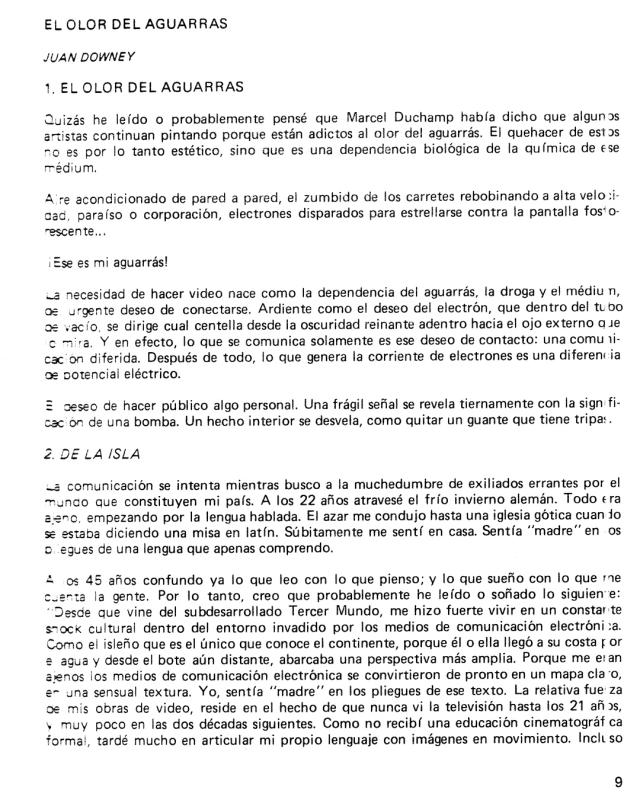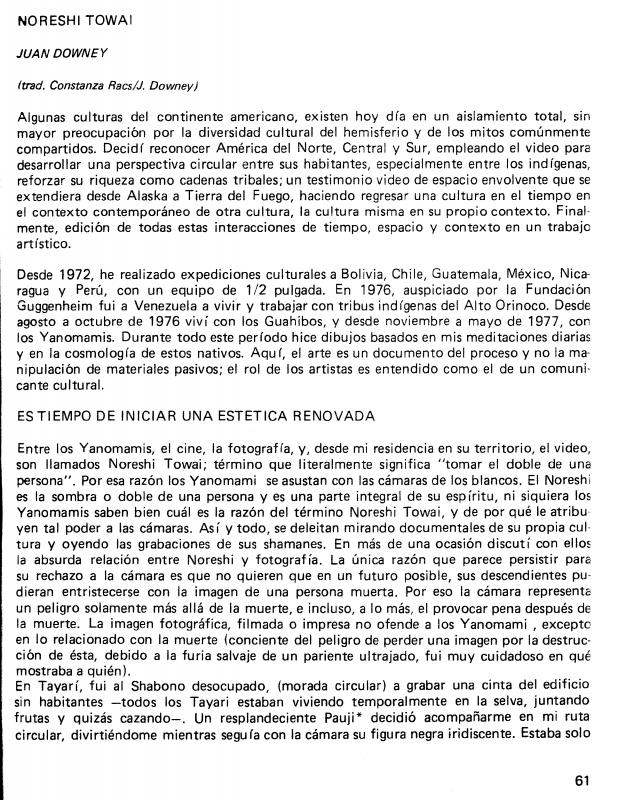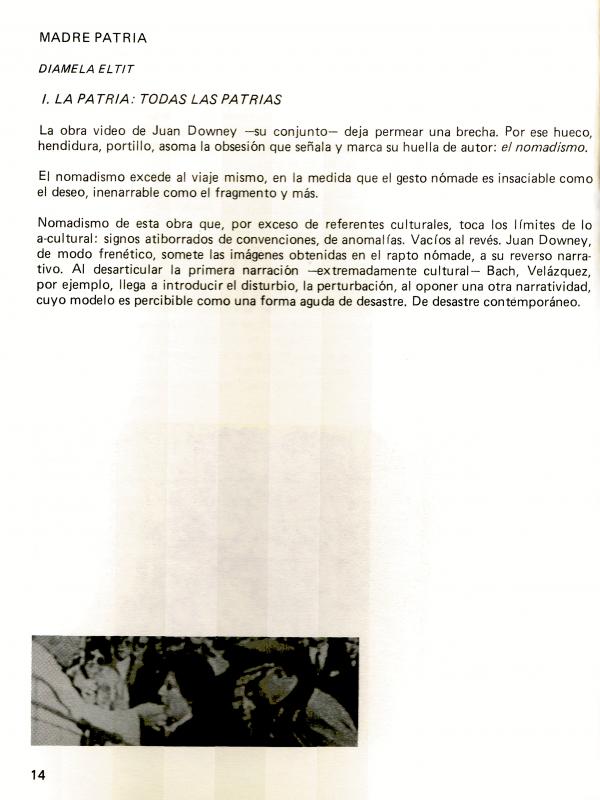The artist Juan Downey (1940–1993) wrote “El olor del aguarrás” [The Smell of Paint Thinner] for his exhibition Festival Downey: Video porque Te Ve at the Galería Visuala (Santiago, 1987). The catalogue for this exhibition included texts by the writer Diamela Eltit (b. 1949), the art critic Justo Pastor Mellado (b. 1949), the North American curator Anne Hoy, the intellectual Patricio Marchant (1939–1990), the anthropologists Pedro Mege and the North American Eric Michaels (1948–1988), the Chilean video artist Néstor Olhagaray (1946–2020), the researcher José Pérez de Arce (b. 1950), and the Chilean archeologist Constantino Torres, who lived in the United States. These different perspectives underscore the complexity of a body of work that reflected deeply on its medium, its exhibition potential, and the complexities of culture and life in society, politics, and history. [For other texts in this catalogue, see the following in the ICAA Digital Archive: by Mellado, both “El misterio de la Gran Pirámide” (doc. no. 735702) and “El ojo de la papa: autobiografía y video en la obra de Juan Downey” (doc. no. 735710); “Juan Downey y el video espejo” (doc. no. 735687) by Pérez de Arce; “Videos de Juan Downey: arte como experiencia” (doc. no. 735754) by Torres; see also “Video arte y autobiografía” (doc. no. 735821) by Marchant.]
Juan Downey was a pioneer of video art, though he also worked in other fields, including drawing, printmaking, and painting. As a self-taught artist, Downey’s career was characterized by medial explorations that allowed him to put together an unprecedented body of work. After graduating with a degree in architecture, he left Chile and went to Germany, studied painting in Spain, and became interested in printmaking in France. He eventually settled in the United States, where he started dabbling in technology. He produced Invisible communication (1967) at that time, a sculpture that was activated by interacting with viewers. The feminist art critic Ann-Sargent Wooster reviewed this period in detail in “Juan Downey” (doc. no. 739219). After producing works of this kind, he sought to reconnect with his roots through other cultures, as in Trans Américas (1973–76), his lengthy series based on a number of trips in Latin America where he recorded Indigenous tribes interacting with the landscapes and social environments. At first, he set out to generate a connection between one place and another by showing a tribe or culture the footage he had previously shot of other such groups somewhere else. “El olor del aguarrás,” which Downey wrote fifteen years after he began working on his most ambitious project, hints at an openness and a failure of some kind in the subtitle, “No se descifra nada haciendo videos” [Nothing can be deciphered by making videos], indicating his profound self-criticism concerning his initial beliefs about the sociopolitical potential of making works, though he does note the importance of them taking charge of their own context. [For more information on this project in the artist’s words see: “Noreshi Towai” (doc. no. 735718), and for a review of his work from an anthropological perspective, see both “Cómo vernos viendo a los Yanomami, viéndonos” (doc. no. 735781) by Eric Michaels and “A propósito de ‘Yanomami (1977)’” (doc. no. 735727) by Néstor Olhagaray.]
Downey planned his videos based on his detailed thinking about the relationship between an audiovisual production, the exhibition space, and the viewers, which required complex installations of monitors, speakers, and other equipment. “El viaje” [The Journey] as self-discovery and technical experimentation were constants in his work, and his immigrant status influenced his work. Chile was one of his obsessions, and his videos can be seen as a constant tribute, as suggested by Eltit in “Madre Patria” (doc. no. 735694). He had a couple of solo exhibitions before leaving Chile, and didn’t show his work in his country again until the mid-1980s. In 1984 he presented 20 años de dibujos, grabados y videos at the Galería Plástica 3, and in 1987 he showed Festival Downey: Video porque Te Ve at the Galería Visuala (both in Santiago). His body of work has been discussed by several authors who have noted his interests in ecology, extra-activism, mass culture, and multiculturalism. [For other readings of this artist’s work, see: “Viaje hacia la totalidad” (doc. no. 739212) by Carlos Aldunate; “Juan Downey: el dibujo como paradoja” (doc. no. 739194) by Mary Sabbatino; and “Reelaborando la modernidad de Juan Downey en The thinking eye” (doc. no. 739203) by John Hanhardt.]








